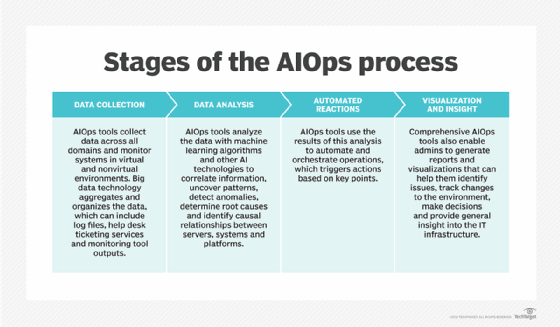
Getty Images
Manage complexity in Kubernetes with AI and machine learning
Learn how DevOps teams can enhance performance and observability in Kubernetes with AI and machine learning techniques. Evaluate pros, cons and use cases.
Kubernetes' distributed, dynamic nature is well suited for modern software architectures. But the platform's complexity and the intricate structure of today's cloud-native applications pose obstacles to monitoring Kubernetes deployments.
In Kubernetes environments, observability involves collecting and analyzing metrics, logs and traces to identify issues, diagnose problems and optimize cluster performance. Tracing requests across a microservices-based application stack can be difficult, however. Handling the sheer volume of data generated by Kubernetes clusters and containerized applications creates additional challenges.
Applying AI and machine learning (ML) can help IT teams sort through noise and yield actionable intelligence about cluster operations and health. But don't get caught up in the hype. To make the most of these techniques in Kubernetes, it's essential to look past the misconceptions about AI and ML as well as carefully weigh their limitations.
Use cases for AI and ML in Kubernetes environments
Several areas of Kubernetes observability and management are particularly well suited to AI and ML. Regardless of which you choose, be cautious and start small.
Approach adopting AI and ML in Kubernetes with a pilot project that involves input and feedback from your organizations' key Kubernetes experts. Document lessons learned, then expand to other Kubernetes projects that could benefit from observability and performance improvements.

1. Anomaly detection and root cause analysis
AI and ML models trained to detect anomalous behavior in Kubernetes clusters and applications can help operations teams proactively address issues before they escalate.
Anomaly detection is as much of an art as a science. Because AI systems can identify patterns and correlations in data that humans might miss, these models are an option for supporting ops staff who have limited anomaly detection experience. Although AI is no substitute for a seasoned Kubernetes expert, using AI to support engineers can lead to more accurate and efficient issue detection and analysis.
Likewise, using an AI tool to detect the root causes of issues in Kubernetes clusters and applications can reduce the time and effort needed for troubleshooting. The continuing shortage of Kubernetes expertise makes AI for root cause analysis especially compelling for enterprises seeking to extend and preserve their limited in-house Kubernetes expertise.
2. Performance optimization
AI and ML can enhance the performance of Kubernetes clusters and applications by identifying bottlenecks and recommending optimizations. Based on system data and performance metrics, AI tools can identify potential problem areas and suggest ways to improve user experience and satisfaction.
AI can't replace a seasoned Kubernetes administrator when it comes to performance optimization. But insights from AI tools can help less-experienced Kubernetes administrators make decisions and tackle more performance optimization tasks.
3. Predictive capacity planning
AI systems can learn the complex relationships among workload characteristics and existing resource use patterns to predict future resource use more accurately.
Based on these analyses, AI tools can help predict resource use and demand in Kubernetes clusters, enabling IT teams to plan and allocate resources more effectively and sustainably. This type of AI support can help ops team members of all experience levels by offering new data points to factor into capacity planning.
Drawbacks and limitations of AI and ML for Kubernetes
AI hype is at a frenzied level in the IT industry right now, with no signs of stopping. Consequently, it's especially important to be practical and perform due diligence when evaluating AI and ML tools for Kubernetes.
As with other AI use cases, the potential for model bias and inaccurate predictions is a definite limitation of AI for Kubernetes. Because models are only as good as the data they're trained on, AI predictions based on nonrepresentative or otherwise inadequate data can be unreliable and inaccurate. Models in production require retraining as their performance degrades over time due to changes in workload characteristics or the underlying environment.
The interpretability of models' outputs is another drawback. Due to the black box nature of AI and ML, it can be challenging to understand why a model made a particular decision. This, in turn, might make some teams less willing to trust insights or suggestions that come from an AI system.
Privacy and security concerns will always be part of AI and ML implementations. Using these technologies in enterprise environments could involve the collection of sensitive data, raising concerns about data protection, user privacy and compliance.
Tooling options for exploring AI in Kubernetes
Various AI and ML products designed for Kubernetes environments are already on the market:
- KubeLinter. This is an open source static analysis tool for Kubernetes YAML files and Helm charts. It uses AI and ML techniques to ensure consistency and reduce errors when creating Kubernetes resources.
- Prometheus. This is an open source monitoring and alerting tool for enterprise-level Kubernetes observability. It uses AI and ML to collect and analyze metrics and provide insights into the performance and health of Kubernetes clusters.
- Grafana. This is an open source data visualization and monitoring platform. Its AI and ML capabilities include anomaly detection and forecasting.
- Dynatrace. This is an observability platform that offers comprehensive visibility into Kubernetes environments. Dynatrace uses ML algorithms to detect anomalies and provide actionable insights designed to improve performance and reduce downtime.





